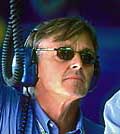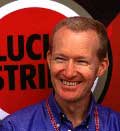Team Principals
 Managin Director - Craig Pollock
Managin Director - Craig Pollock
Managing Director of British American Racing, Formula One's newest contender, Craig Pollock managed in just one year to build a team, travel all over the world publicising it, and oversee construction of the sport's most modern facility. In January 1998, the British American Racing team numbered a handful of individuals working out of a variety of facilities. Just two years later, 280 team members are housed at the team's impressive Brackley headquarters.
It took a determined 43-year-old with an eclectic background to shepherd the process. Born in Scotland in 1956, Pollock taught physical education in Keith and then, after two years in business, went on to become a physical education teacher in Switzerland. At a private school there, one of his pupils was Jacques Villeneuve, son of Ferrari Grand Prix legend, Gilles Villeneuve, and a youngster already known for his speed on the ski slopes.
Pollock left education in the mid-1980s and became involved in a number of business projects, some related to motor racing, for assorted European and Japanese interests.
In 1993, Villeneuve sought out Pollock to act as his personal and business agent. Pollock agreed, and steered the young Canadian through the intricacies of contract negotiations in Formula Atlantic and IndyCar before moving on to Formula One. Villeneuve's successes, including victory in the 1995 Indianapolis 500 and drivers' titles in both the PPG Indy Car World Series (1995) and FIA Formula One World Championship (1997) all reflected on his manager.
When British American Racing came together in November 1997, Craig Pollock was aboard as a founding partner and Managing Director. One of the most recognised international personalities in Formula One today, he is typical of the sport's new generation: multi-lingual (English, French and "Swiss" German), multi-talented and totally dedicated to the task at hand. The team he was to assemble reflects the same qualities.
Pollock's self-confidence comes from a willingness to take risks and work hard. Coming in second is not for him, he says. "I am willing to work day and night, and weekends, to ensure the success of British American Racing," he says, "and I expect the same level of commitment from the entire team. At the same time, I'd like to think we could also have some fun along the way."
The team has been constructed to be competitive in the shortest possible time. Quality is essential. "I want the best for the team: the best engine, the best chassis, the finest engineers - and the greatest drivers," Pollock says emphatically. "I am dedicating all of my energies to the team in order to help it achieve what I know will be future success."
 Technical Development Director - Dr. Adrian Reynard
Technical Development Director - Dr. Adrian Reynard
Considering Adrian Reynard's impressive experience in motor sport, one might make the mistake of presuming there are few thrills left for the 48-year-old engineer. The assumption would be wrong. Each new challenge rekindles the passion that has always driven the man with one of motorsport's most inventive and entrepreneurial minds.
This certainly holds true for Dr Reynard's key role as founding partner and Technical Development Director of British American Racing. After amassing one of the most successful records in motor racing during the 1980s and 1990s, the move to Formula One was "the logical next step" for Reynard Racing Cars.
The Reynard design team, headed by Malcolm Oastler, who subsequently became British American Racing Technical Director, boasts a very special distinction - up to 1999, it helped Reynard become the only manufacturer in the world to win the first race of every major single-seater championship in which it competed.
Adrian Reynard is very aware, however, that there can be no resting on one's laurels in motorsport. "I'm very conscious of that old saying that 'you're only as good as your last win', he says. Yes, we have enjoyed a lot of success at other levels of racing, but Formula One is the ultimate test for all of us, as the 1999 season clearly proved."
Dr. Reynard built his first racing car in 1973, as a student project, and joined British Leyland as a Project Engineer a year later. In 1977, he took up a full-time position as CEO of Sabre Automotive/Reynard Racing Cars Ltd. and tasted his first success in 1979, when his cars won the European and British Formula Ford 2000 Championships. The company also helped pioneer carbonfibre monocoque (unibody chassis) technologies in the 1980s, and continues to carry out pioneering work in this field at its new factory adjacent to the British American Racing headquarters at Brackley.
Reynard-designed cars also have the distinction of having won the fabled Indianapolis 500 twice. In 1997, Adrian Reynard was elected a companion of the Royal Aeronautical Society, in recognition of his company's pioneering technologies, and was recently appointed Professor of Engineering and Applied Sciences at Cranfield University.
Reynard currently carries out consultancy work on behalf of a number of automotive companies in North America and Japan, as well as several leading British manufacturers. In 1990 and 1996, the company was awarded the Queen's Award for Export Achievement, the first racing car company so honoured twice.
In March 1994, Reynard entered the IndyCar World Series, winning the first time out from the front row of the grid. A year later, Reynard chassis drove away with the Constructors' and Drivers' championships, as well as victory in the Indy 500. The company has gone on to dominate the North American racing series for the last five years, and the trend looks set to continue in 2000.
 Technical Director - Malcolm Oastler
Technical Director - Malcolm Oastler
Technical Director for British American Racing, Malcolm Oastler has been involved in the design of successful racing cars since the mid-1980s.
Interested in cars from an early age, Malcolm raced in Australian Formula Ford in 1983 and 1984, finishing second in the National championship in his rookie year. Before embarking on his racing activities, though, he had received a degree from New South Wales University of Technology in Sydney with first class honours.
He moved to the United Kingdom in February 1985, to work as a mechanic in Formula Ford 1600 and Formula Ford 2000, and also drove in FF2000, albeit with limited success. Deciding that his aspirations to become a world-class driver might not be realistic, Malcolm turned to racing car design.
Oastler joined Reynard in 1986, designing the company's Formula Ford 1600 and Formula Ford 2000 chassis. In 1988, he collaborated with Adrian Reynard on the first Reynard Formula 3000 chassis, and his designs won five titles in as many seasons. When the Indy car concept became a reality in 1994, Malcolm led the design team from the start. His 95I chassis won eight races, including the prestigious Indianapolis 500, and started from pole position no less than 13 times.
Oastler readily admits that 1998 was an interesting time for him and his team, as they began to focus on the challenges of Grand Prix racing. "In many ways, the design team had the easier job," he says. "Whereas Craig (Pollock), Rick (Gorne) and the others had to assemble a complete team from scratch, we could just focus on the task of designing and building the car - not that it's a simple task at all! The complexity of a modern Formula One car means the design process simply cannot be handled by one person alone."
"This year's chassis, the BAR002, is a carefully considered evolution of the previous year's car, incorporating many of the hard-won lessons we took away from 1999," continues Oastler. "Like its predecessor, it is the collective work of the whole technical team. The difference compared with the first year, though, is that this is now a 'battle-hardened' group of people who have lived through the trials and tribulations of a full season of Grand Prix racing. There is no doubt that shared experience has brought everyone together as a more unified team.
"As a result, the BAR002 has benefited from improved communication between the team's technical personnel as well as from a far greater degree of in-house component manufacture. This, in turn, has led to significantly improved quality control, easier maintenance of the car and improved reliability. With a major technical undertaking such as Formula One, you have to have a baseline from which to start. The 1999 car was our baseline. This year's represents the next step forward, and we're quietly pleased with the result."
The Drivers
Click on the thumbnail to view the image in full size

